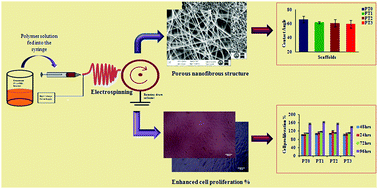当前位置:
X-MOL 学术
›
New J. Chem.
›
论文详情
Our official English website, www.x-mol.net, welcomes your feedback! (Note: you will need to create a separate account there.)
Development of nanofibrous scaffolds by varying the TiO2 content in crosslinked PVA for bone tissue engineering
New Journal of Chemistry ( IF 3.3 ) Pub Date : 2020/01/11 , DOI: 10.1039/c9nj05118j Nandini A. Pattanashetti 1, 2, 3, 4 , Chinmay Hiremath 1, 2, 3, 4 , Satishkumar R. Naik 1, 2, 3, 4 , Geetha B. Heggannavar 1, 2, 3, 4 , Mahadevappa Y. Kariduraganavar 1, 2, 3, 4
New Journal of Chemistry ( IF 3.3 ) Pub Date : 2020/01/11 , DOI: 10.1039/c9nj05118j Nandini A. Pattanashetti 1, 2, 3, 4 , Chinmay Hiremath 1, 2, 3, 4 , Satishkumar R. Naik 1, 2, 3, 4 , Geetha B. Heggannavar 1, 2, 3, 4 , Mahadevappa Y. Kariduraganavar 1, 2, 3, 4
Affiliation

|
The use of ceramic and metal nanoparticles is widely being proven as a preferred candidate for tissue engineering owing to their excellent properties such as their high penetration ability and high surface area with tuneable surface properties. In view of this, the effect of bioinert TiO2 incorporation into the polymer matrix is studied in the present study. Crosslinked poly(vinyl alcohol) (PVA) was used as the main polymer base and different weight percentages of TiO2 (0.1 to 0.3 g) were incorporated into the crosslinked PVA matrix by varying the ratio of PVA : TiO2. Nanofibrous scaffolds were then fabricated using the electrospinning technique. The physicochemical properties of the developed nanofibrous scaffolds were analysed systematically. Scanning electron microscopy images demonstrated the good interconnected porous structure with uniform fibres in the range of several hundreds of nanometres. The effect of TiO2 incorporation was observed in terms of an increase in the hydrophilicity of the scaffolds required for cellular infiltration. The mechanical characterization of the developed scaffolds demonstrated an improved mechanical strength for a reduced amount of TiO2 incorporated scaffolds. The degradation study revealed the slow rate of degradation with an increase in the TiO2 content in the PVA matrix of the scaffolds. Cell viability was studied using MG-63 bone osteosarcoma cells for 24, 48, 72 and 96 h, wherein the PT1 scaffold with a content of 0.1 g of TiO2 exhibited the highest cell proliferation of 99.2%. The results thus clearly show that the TiO2 incorporated PVA scaffolds could be potential candidates for bone tissue engineering.
中文翻译:

通过改变交联的聚乙烯醇中的TiO2含量开发用于骨组织工程的纳米纤维支架
陶瓷和金属纳米颗粒的使用,由于其优异的性能,例如高渗透能力和具有可调节表面性能的高表面积,已被广泛证明是组织工程的首选。鉴于此,在本研究中研究了将生物惰性TiO 2掺入聚合物基质中的作用。使用交联聚乙烯醇(PVA)作为主要聚合物基础,并通过改变PVA:TiO 2的比例将不同重量百分比的TiO 2(0.1至0.3 g)掺入交联PVA基体中。然后使用静电纺丝技术制造纳米纤维支架。系统分析了开发的纳米纤维支架的理化性质。扫描电子显微镜图像显示了良好的相互连接的多孔结构,其均匀纤维在几百纳米的范围内。观察到TiO 2掺入的作用是细胞渗透所需支架的亲水性增加的结果。所开发的支架的机械特性显示出降低的掺入TiO 2的支架的机械强度得到了改善。降解研究表明,随着TiO 2含量的增加,降解速度变慢。支架的PVA矩阵中的含量。使用MG-63骨骨肉瘤细胞研究了24、48、72和96 h的细胞活力,其中含量为0.1 g TiO 2的PT1支架表现出最高的细胞增殖率,为99.2%。因此,结果清楚地表明,掺入TiO 2的PVA支架可能是骨组织工程的潜在候选者。
更新日期:2020-02-10
中文翻译:

通过改变交联的聚乙烯醇中的TiO2含量开发用于骨组织工程的纳米纤维支架
陶瓷和金属纳米颗粒的使用,由于其优异的性能,例如高渗透能力和具有可调节表面性能的高表面积,已被广泛证明是组织工程的首选。鉴于此,在本研究中研究了将生物惰性TiO 2掺入聚合物基质中的作用。使用交联聚乙烯醇(PVA)作为主要聚合物基础,并通过改变PVA:TiO 2的比例将不同重量百分比的TiO 2(0.1至0.3 g)掺入交联PVA基体中。然后使用静电纺丝技术制造纳米纤维支架。系统分析了开发的纳米纤维支架的理化性质。扫描电子显微镜图像显示了良好的相互连接的多孔结构,其均匀纤维在几百纳米的范围内。观察到TiO 2掺入的作用是细胞渗透所需支架的亲水性增加的结果。所开发的支架的机械特性显示出降低的掺入TiO 2的支架的机械强度得到了改善。降解研究表明,随着TiO 2含量的增加,降解速度变慢。支架的PVA矩阵中的含量。使用MG-63骨骨肉瘤细胞研究了24、48、72和96 h的细胞活力,其中含量为0.1 g TiO 2的PT1支架表现出最高的细胞增殖率,为99.2%。因此,结果清楚地表明,掺入TiO 2的PVA支架可能是骨组织工程的潜在候选者。


























 京公网安备 11010802027423号
京公网安备 11010802027423号